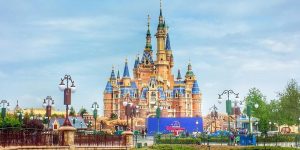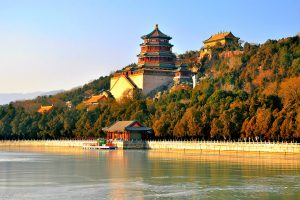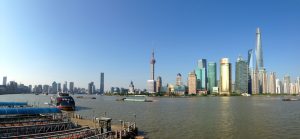 The Terracotta Army Museum is divided into three pits. After going inside, keep in mind that don’t take photos with the terracotta warriors, the tour guide will tell you that after all it is a funerary, and it is a bit suffocating.
The Terracotta Army Museum is divided into three pits. After going inside, keep in mind that don’t take photos with the terracotta warriors, the tour guide will tell you that after all it is a funerary, and it is a bit suffocating.
The Terracotta Warriors developed today are only three over ten thousand of that very year.
The first pit is the largest of the three pits. The tour guide will also tell you that the terracotta warriors here are all single eyelids. It is said that Qin Shihuang thought that the people with double eyelids are more serious. If you want to be a high official, you can’t be double eyelids. But Qin Shihuang himself is a person with double eyelids.
The head and body of each terracotta warrior are separated, and the high collar is used to cover the gap between the joints.
All the terracotta warriors are higher than the actual height of the Qin Dynasty soldiers. The people in the Qin Dynasty are generally around 160-170CM high, while the terracotta warriors are generally above 172cm. The reason is that Qin Shihuang wanted to create a feeling of grandeur.
There is no large-scale excavation in the No. 2 pit, and it is also a soil slope. There is a cabinet in the back showing the typical terracotta figures. The wrinkles of the collar, the elaboration of the beard and the eyebrows, all show the fineness of the sculptor. The hair is particularly clear, the contours of the ears, the eyes are engraved, the lines of the nails and the palms are all there, the waistband of the hemp rope, and the print of the soles, also are showing the meticulousness and difficulty of the carving.
The third pit is the command post, and the right is the place where divination is. You can find some tassels for divination and the place where the ancient prayer war was won.
Tickets: 150 Yuan/person for terracotta warriors, and people under 16 years old or above 70 years old is free of charge.

 Li River is the soul of Guilin, its landscape is the essence of Guilin scenery, and it is the must-visit attraction of Guilin tour.
Li River is the soul of Guilin, its landscape is the essence of Guilin scenery, and it is the must-visit attraction of Guilin tour. 2, The essence of drifting (ie go to Yangdi or Xingping for drifting):
2, The essence of drifting (ie go to Yangdi or Xingping for drifting): Suzhou has never lacked the unique tone that the regions south of the Yangtze River exclusively has. The old city of Suzhou is not big. If it is the first time to come to Suzhou, the garden must be included in your itinerary, such as The Humble Administrator’s Garden, Lion Grove Garden, Lingering Garden, Net Master Garden, etc. if you are interested in history, then you can go to Tiger Hill and Hanshan Temple. If there is enough time, don’t forget to choose a few ancient towns nearby to have a visit. The famous ones are Zhouzhuang and Tongli Ancient Towns. The nearest one is the MuDu Ancient Town, even if it is just in a daze, it is good choice for you. If you love the scenery between mountains and rivers, then go to Taihu Lake or go to Tianping Mountain. Dongshan and Xishan are unpopular, but the scenery is absolutely stunning there.
Suzhou has never lacked the unique tone that the regions south of the Yangtze River exclusively has. The old city of Suzhou is not big. If it is the first time to come to Suzhou, the garden must be included in your itinerary, such as The Humble Administrator’s Garden, Lion Grove Garden, Lingering Garden, Net Master Garden, etc. if you are interested in history, then you can go to Tiger Hill and Hanshan Temple. If there is enough time, don’t forget to choose a few ancient towns nearby to have a visit. The famous ones are Zhouzhuang and Tongli Ancient Towns. The nearest one is the MuDu Ancient Town, even if it is just in a daze, it is good choice for you. If you love the scenery between mountains and rivers, then go to Taihu Lake or go to Tianping Mountain. Dongshan and Xishan are unpopular, but the scenery is absolutely stunning there.
 The West Lake, located in the west of Hangzhou, Zhejiang Province, is one of the first national key scenic spots in China and one of China’s top ten scenic spots. It is one of the main ornamental freshwater lakes in mainland China. This West Lake is very suitable for those couple who are falling in love to have a visit for dating. How can you not go to West Lake when you are at Hangzhou? A lot of people think that the fall of the West Lake is the most beautiful, although there are no spring blossoms, the colorful leaves can bring out the beauty of the West Lake. However, if you are not color control, you can also try to shoot the effect like those Chinese painting. Walking around the West Lake under the comfortable sunshine, looking at the broken bridge, the crowd is moving, but you will feel the bridge is even smaller.
The West Lake, located in the west of Hangzhou, Zhejiang Province, is one of the first national key scenic spots in China and one of China’s top ten scenic spots. It is one of the main ornamental freshwater lakes in mainland China. This West Lake is very suitable for those couple who are falling in love to have a visit for dating. How can you not go to West Lake when you are at Hangzhou? A lot of people think that the fall of the West Lake is the most beautiful, although there are no spring blossoms, the colorful leaves can bring out the beauty of the West Lake. However, if you are not color control, you can also try to shoot the effect like those Chinese painting. Walking around the West Lake under the comfortable sunshine, looking at the broken bridge, the crowd is moving, but you will feel the bridge is even smaller.
 It is said that you cannot be a real hero without climbing the Great Wall. For this saying, mostly it is because the Great Wall is the most famous attraction In China, and even one of the well-known attractions all over the world. And when visiting the Great Wall, the Badaling Great Wall is the most preferred choices for visitors.
It is said that you cannot be a real hero without climbing the Great Wall. For this saying, mostly it is because the Great Wall is the most famous attraction In China, and even one of the well-known attractions all over the world. And when visiting the Great Wall, the Badaling Great Wall is the most preferred choices for visitors.
 Going to Shanghai Disneyland can’t take a selfie stick and a large bottle of water/beverage, or too many snacks. Be sure to bring a cup, preferably with a little drink. Because there are a lot of free water available for you to drink in Disney, but it costs 10 Yuan to buy ice water and 15 Yuan to buy drinks. After you take the tickets, you must keep them. Don’t think about taking pictures when you enter the Shanghai Disneyland, and don’t go slowly, be sure to run, run to the left, go to Adventure Island and enjoy flying to the horizon, this is one of Shanghai Disneyland’s most popular projects.
Going to Shanghai Disneyland can’t take a selfie stick and a large bottle of water/beverage, or too many snacks. Be sure to bring a cup, preferably with a little drink. Because there are a lot of free water available for you to drink in Disney, but it costs 10 Yuan to buy ice water and 15 Yuan to buy drinks. After you take the tickets, you must keep them. Don’t think about taking pictures when you enter the Shanghai Disneyland, and don’t go slowly, be sure to run, run to the left, go to Adventure Island and enjoy flying to the horizon, this is one of Shanghai Disneyland’s most popular projects.
 There are 33 buildings on the Bund, some of which are still expropriated by some units. For example, the Bund No. 13 Customs Building, which was built in the 16th year of the Republic of China (1927), is still the residence of Shanghai Customs; the Bund No. 14 Bank of Communications, is the youngest architecture on the Bund, which was completed in the 37th year of the Republic of China (1948) and has been used by the Shanghai Federation of Trade Unions since its establishment. Others are the headquarters of high-ranking banks and insurance companies and high-end hotels, such as the Bund No.1 Asiatic Building, which was built in 1913; the Nisshin Building, also known as the Maritime Building, was built in the 14th year of the Republic of China (1925), and it was originally the building of Nissin company; The HSBC Building, also known as the City Hall, was built in the 14th year of the Republic of China (1925); the British General Assembly, 110.7-foot bar cabinet is the longest in the East, and now it is the Dongfeng Hotel; The Bund No. 19 Confucius Hotel Building today is the Peace Hotel; the Bund No. 22 Shaxun Building, was built in the 18th year of the Republic of China (1929) and is the tallest building on the Bund, but today it also belongs to the Peace Hotel. The Bund No. 3, No. 6, and No. 18 were refurbished and developed into high-end leisure shopping and entertainment venues, which are the coordinates of Shanghai’s luxury consumption.
There are 33 buildings on the Bund, some of which are still expropriated by some units. For example, the Bund No. 13 Customs Building, which was built in the 16th year of the Republic of China (1927), is still the residence of Shanghai Customs; the Bund No. 14 Bank of Communications, is the youngest architecture on the Bund, which was completed in the 37th year of the Republic of China (1948) and has been used by the Shanghai Federation of Trade Unions since its establishment. Others are the headquarters of high-ranking banks and insurance companies and high-end hotels, such as the Bund No.1 Asiatic Building, which was built in 1913; the Nisshin Building, also known as the Maritime Building, was built in the 14th year of the Republic of China (1925), and it was originally the building of Nissin company; The HSBC Building, also known as the City Hall, was built in the 14th year of the Republic of China (1925); the British General Assembly, 110.7-foot bar cabinet is the longest in the East, and now it is the Dongfeng Hotel; The Bund No. 19 Confucius Hotel Building today is the Peace Hotel; the Bund No. 22 Shaxun Building, was built in the 18th year of the Republic of China (1929) and is the tallest building on the Bund, but today it also belongs to the Peace Hotel. The Bund No. 3, No. 6, and No. 18 were refurbished and developed into high-end leisure shopping and entertainment venues, which are the coordinates of Shanghai’s luxury consumption. When having a travel to Beijing, The Palace Museum (known as the Forbidden City) is a must-see attraction. Before going there, just have a review on it from other visitors’ experience there.
When having a travel to Beijing, The Palace Museum (known as the Forbidden City) is a must-see attraction. Before going there, just have a review on it from other visitors’ experience there.